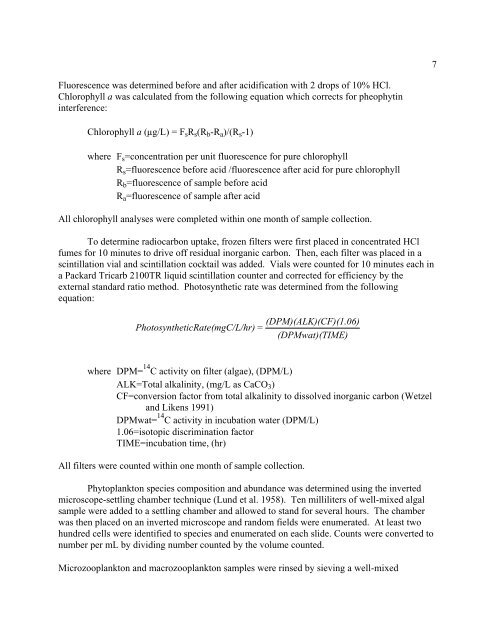NEW: Annual Report - George Mason University
NEW: Annual Report - George Mason University
NEW: Annual Report - George Mason University
Create successful ePaper yourself
Turn your PDF publications into a flip-book with our unique Google optimized e-Paper software.
Fluorescence was determined before and after acidification with 2 drops of 10% HCl.<br />
Chlorophyll a was calculated from the following equation which corrects for pheophytin<br />
interference:<br />
Chlorophyll a (µg/L) = FsRs(Rb-Ra)/(Rs-1)<br />
where Fs=concentration per unit fluorescence for pure chlorophyll<br />
Rs=fluorescence before acid /fluorescence after acid for pure chlorophyll<br />
Rb=fluorescence of sample before acid<br />
Ra=fluorescence of sample after acid<br />
All chlorophyll analyses were completed within one month of sample collection.<br />
To determine radiocarbon uptake, frozen filters were first placed in concentrated HCl<br />
fumes for 10 minutes to drive off residual inorganic carbon. Then, each filter was placed in a<br />
scintillation vial and scintillation cocktail was added. Vials were counted for 10 minutes each in<br />
a Packard Tricarb 2100TR liquid scintillation counter and corrected for efficiency by the<br />
external standard ratio method. Photosynthetic rate was determined from the following<br />
equation:<br />
(DPM)(ALK) (CF)(1.06)<br />
Photosynth eticRate(mgC/L/hr)<br />
=<br />
(DPMwat)(TIME)<br />
where DPM= 14 C activity on filter (algae), (DPM/L)<br />
ALK=Total alkalinity, (mg/L as CaCO3)<br />
CF=conversion factor from total alkalinity to dissolved inorganic carbon (Wetzel<br />
and Likens 1991)<br />
DPMwat= 14 C activity in incubation water (DPM/L)<br />
1.06=isotopic discrimination factor<br />
TIME=incubation time, (hr)<br />
All filters were counted within one month of sample collection.<br />
Phytoplankton species composition and abundance was determined using the inverted<br />
microscope-settling chamber technique (Lund et al. 1958). Ten milliliters of well-mixed algal<br />
sample were added to a settling chamber and allowed to stand for several hours. The chamber<br />
was then placed on an inverted microscope and random fields were enumerated. At least two<br />
hundred cells were identified to species and enumerated on each slide. Counts were converted to<br />
number per mL by dividing number counted by the volume counted.<br />
Microzooplankton and macrozooplankton samples were rinsed by sieving a well-mixed<br />
7
















